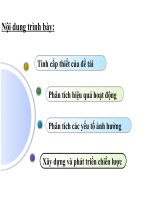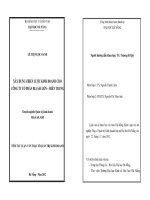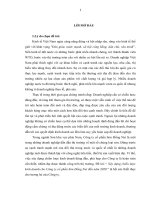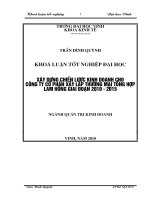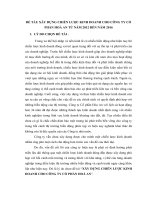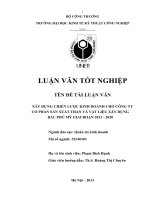Xây dựng chiến lược kinh doanh cho công ty cổ phần thiết bị VINACOMIN từ 2015 đến 2020
Bạn đang xem bản rút gọn của tài liệu. Xem và tải ngay bản đầy đủ của tài liệu tại đây (1.94 MB, 73 trang )
LUẬN VĂN THẠC SĨ
Xây dựng chiến lược kinh doanh cho công ty cổ phần thiết bị
VINACOMIN từ 2015 đến 2020
THESIS MBA
BUILDING BUSINESS STRATEGY FOR
VINACOMIN MACHINERY JOINT STOCK COMPANY
FROM 2015 TO 2020
Vinacomin Machinery Joint Stock Company (VMC in abbreviation form)
having headquarter at No. 486, Tran Phu Road, Cam Pha Town, Quang Ninh
Province would like to give some comments on the working period of the MBA
program’s group of students and assessment of the report: “BUILDING BUSINESS
STRATEGY FOR VINACOMIN MACHINERY JOINT STOCK COMPANY
FROM 2015 TO 2020” proposed by the group.
1. About the working period at VMC.
The researching group with four members has contacted and come to work at
VMC since October 26th, 2009. In the receiving and working meeting with the group
of students, VMC Director very welcomed the intention and researching content
presented by the group’s leader.
Board of Directors committed to provide necessary document, hold practical trip
(if necessary) and arrange workroom at VMC for the group when they came to collect
data or hold discussions.
In the working period at VMC (from October 26 th to December 12th, 2009) the
group seriously observed the Company’s rules and regulations, had serious working
attitude, prudent and reasonable behaviors.
In the data collecting, analyzing and report drafting process, the researching
group held two workshops to present draft strategy and consulted the opinions of the
Company board of leaders.
All the document and reports borrowed by the group were returned sufficiently
on December 12th, 2009.
2. Assessment of the report’s content.
Under the academic viewpoint about building and administrating strategy, VMC
does not have any comment on the report. The report has applied tools to analyze
ii
models methodically and particularly helped VMC locate ourselves and be aware of
our status on the synthesis of business environment elements.
Under practical viewpoint, the report has mapped out the business strategy of
VMC from now to 2015 logically and practically. Most importantly, VMC is very
satisfied with the detailed solutions recommended by the report to realize the
fundamental targets of the strategy.
The report’s applicability to reality is its core value. VMC realizes that this
business strategy is very suitable and fairly detailed to VMC in this period; at the
same time it does not go against the strategic orientation of the Vietnam National
Coal - Mineral Industries Group as well as the Prime Ministerial Decision
186/2002/QĐ-TTg, dated December 26th, 2002. VMC board of leaders will accept this
report (offered to VMC by the group) and continue to perfect it to set the basis for the
implementation of our business strategy in 2010-2015 period.
Finally, on behalf of the staff and workers of Machinery Joint Stock Company –
Vietnam National Coal – Mineral Industries Group, I would like to thanks teachers
and students for your affection and interest in our Company. We hope that the relation
between study and research is always attached to reality and supports organizations
and enterprises as the way University of Griggs - USA and Center for Educational
Technology and Career Development – Vietnam National University have oriented
their groups of students recently.
We would like to sincerely thank and wish healthy all the teachers and students
of MBA program, Griggs University – USA and Center for Educational Technology
and Career Development – Vietnam National University.
Recipients:
COMPANY’S DIRECTOR
-
As dear;
-
The group of students;
-
Save at personal department, archives.
iii
ACKNOWLEDGEMENT
We would like to express our gratitute to all those who gave us the possibility
to complete this capstone project report. We would like to thank Teachers of Griggs
University and Educational and Training Center – Vietnam National University for
organizing this great MBA program.
We also would like to thank VINACOMIN, especially Dr. Phung Manh Dac –
Deputy General Director of Vietnam National Coal – Mineral Industries Group,
Chairman of Administration Board of VMC Company; Dr. Ta Ngoc Hai – Mechanics
Department Manager, Vietnam Coal – Mineral Industries Group; Mr. Cao Ngoc Dau
– Institute Head of Mine Energy Mechanics and Mr. Nguyen Cong Hoan – Director
of VMC company for contributing ideas and creating conditions for us to complete
this report, without them this report could not be completed.
We would like to give our special thanks to our families for their patience,
support and encouragement during all the time we carried on this capstone project
report as well as the entire period of the MBA program.
Bui Ngoc Lan
Mai Ngoc Thach
Le Van Bang
Duong Bao Linh
iv
CONTENTS
ACKNOWLEDGEMENT........................................................................................................iv
CONTENTS...............................................................................................................................v
List of abbreviated words........................................................................................................vii
List of tables............................................................................................................................vii
List of figures...........................................................................................................................vii
GENERAL INTRODUCTION..................................................................................................1
Chapter I: REASONING BACKGROUND..............................................................................4
1.1. Overview of business strategy........................................................................................4
1.1.1. Concept of business strategy....................................................................................4
1.1.2. Business strategic management ..............................................................................5
1.1.3. Benefits and limitations in business strategy building.............................................5
1.2. Analyzing environmental factors impact business strategy............................................6
1.2.1. External environment...............................................................................................6
1.2.2. Enterprise’s internal environment............................................................................9
1.3. Building business strategy..............................................................................................9
1.3.1. Information for building strategy.............................................................................9
1.3.2. Expert method to forecast business environment..................................................10
1.3.3. Analyzing matrix SWOT.......................................................................................11
1.3.4. Determining competition status of the enterprise..................................................13
1.4. Choosing business strategy..........................................................................................17
1.4.1. Concentrated growth strategy...............................................................................17
1.4.2. Diversification strategy..........................................................................................18
1.4.3. Integration growth strategy....................................................................................19
1.4.4. Narrowing strategy................................................................................................19
1.4.5. Suitable strategy for living circle of product.........................................................19
1.4.6. Joint venture and association strategy...................................................................19
1.4.7. Competition strategy..............................................................................................19
1.4.8. Brand name strategy..............................................................................................20
1.5. Implementing the strategy...........................................................................................20
1.5.1. Reviewing strategic environment..........................................................................20
1.5.2. Evaluating, adjusting and ensuring resources........................................................21
1.5.3. Determining organization structure to implement the strategy.............................22
1.6. Checking and evaluating business strategy..................................................................22
1.6.1. Controlling basic grounds of company’s strategy.................................................22
1.6.2. Reviewing basis of the strategy.............................................................................23
1.7. Research method of the report......................................................................................23
1.8. Scientific and practical meaning of the report..............................................................23
Chapter II: ANALYZING REAL STATE OF VMC..............................................................25
2.1. Overview of the enterprise............................................................................................25
2.1.1. Process of establishing, developing of VMC.........................................................25
2.1.2. Human resources and organizational structure.....................................................27
2.1.3. Traditional product line of VMC ..........................................................................30
v
2.2. Analyzing situation and results of business activity of VMC from 2005 - 6/2009......34
2.2.1. Business production situation................................................................................35
2.2.2. Market....................................................................................................................36
2.2.3. Business efficiency................................................................................................38
2.3. Analyzing business environment..................................................................................38
2.3.1. Analyzing external environment............................................................................38
2.3.2. Analyzing internal environment............................................................................44
2.4. Results and shortcomings of VMC in the past time.....................................................46
2.4.1. Results....................................................................................................................46
2.4.2. Shortcomings need to be improved.......................................................................47
2.5. Analyzing problems of strategy and administration of VMC.......................................47
2.5.1. General objective of the strategy...........................................................................47
2.5.2. Strategy orientation................................................................................................48
2.5.3. Basic objectives.....................................................................................................48
2.5.4. Impact’s factors......................................................................................................49
Chapter III. SOLUTIONS, RECOMMENDATIONS AND CONCLUSION........................55
3.1. Recommending business strategy.................................................................................55
3.2. Solutions to fundamental implementation and management of business strategies.....55
3.2.1. Modernization of manufacturing technology........................................................56
3.2.2. Modernization of repairing technology.................................................................56
3.2.3. Improvement of ernegy supply system..................................................................57
3.2.4. People development strategy.................................................................................57
3.2.5. Science technology development...........................................................................58
3.2.6. Environment protection and Industrial hygiency...................................................59
3.2.7. Labour protection and Ocupational safety.............................................................60
3.2.8. Corporation............................................................................................................60
3.2.9. Brand name Development.....................................................................................60
3.2.10. Enhancing marketing activity..............................................................................61
3.2.11. Organization.........................................................................................................61
3.3. Proposal........................................................................................................................61
3.4. Conclusion....................................................................................................................62
REFERENCES........................................................................................................................64
vi
List of abbreviated words
VMC
VINACOMIN – Machinery Join Stock Company
WTO
World Trade Organization.
EPC
Engineering - Procurement - Construction
CNC
Computer Numerical Control
FO
Fuel Oil
CAT
Caterpillar Inc.
COALIMEX
Coal Import and Export Joint Stock Company - Vietnam National
Coal – Mineral Industries Group
MATEXIM
Material and Complete Equipment Export - Import Corporation
LILAMA
Vietnam Machinery Erection Corporation
LICOGI
Infrastructure Development and Construction Corporation
VINAINCON
Vietnam Industrial Construction Corporation
IMSAT
Institute for Medical Science and Technology
NARIME
Institute for Mechanical Engineering
List of tables
Table 1.1.
Table 1.2.
Table 2.1.
Table 2.2.
Table 2.3.
Table 2.4.
Table 2.5.
Table 2.6.
Evaluating influences of business environment
Model of theory matrix SWOT
Labor structure of VMC at the time of September 30th, 2009
Labor quality of VMC
Manufacturing, repairing devices capacity of VMC
Results of business activities of VMC from 2005 to June, 2009
Exhibit value of VMC from 2005 to 2009
Value of mechanical production and revenue density of five
11
13
29
30
32
35
36
44
Table 2.7.
Table 2.8.
Table 2.9.
Table 2.8.
inside sector units
Collecting the business environment of VMC
Total score of matrix EFE
Total score of matrix IFE
SWOT matrix of VMC
51
52
52
54
List of figures
Figure 1.1.
Figure 1.2.
Figure 1.3.
Figure 1.4.
Model of competitive forces in ME Porter
Mc Kinsey matrix
IE matrix
Concentrating on a market part
vii
8
13
17
18
Figure 1.5.
Figure 1.6.
Figure 1.7.
Figure 2.1.
Figure 2.2.
Figure 2.3.
Figure 2.4.
Figure 2.5.
Specializing the market
Specialization optionally including many fragments
Specializing products
Organizational structure of VMC
Sale revenue density of outside sectiors
Profit rate on revenue
Competition position of VMC
IE matrix of VMC
viii
18
18
18
31
38
39
50
53
GENERAL INTRODUCTION
Machinery joint stock company directly under Vietnam National Coal –
Mineral Inducstries group, which is abbreviated as VMC (VINACOMIN
Machinery Joint Stock Company) was changed from Cam Pha Central
Mechanics Company. The company was established in 1968, has headquarters
at 486, Tran Phu Road, Cam Pha town, Quang Ninh. For years of building and
developing,
VMC
has
become
the
leading equipment,
accessories
manufacturing company in Vietnam and is gradually reaching to international
market. Products of VMC mainly are equipment, accessories serving mine
ores, cement, and electricity industry in the whole country. Scale of the
enterprise is relatively big with 1,300 staffs and annual revenue is about VND
800 billions. Average growth speed of the company in the last five years has
reached 20%/year. VMC organizes production into groups: accurate
processing, steel component production, rough draft supply (founding,
processing pressure) and other auxiliary production.
At present, VMC is a joint stock company under Vietnam Mine - Mineral
Group. The company has relatively diversified number of commodities, has
many customers of different organizations. For many years, VMC has had
many achievements in business production, contributing to industrialization –
modernization process of Vietnam mechanics sector in general and mine
sector in particular.
To be in accordance with the market economy and international
economic integration that Vietnam is building and developing, implementing
Decree No. 109/2007/NĐ-CP dated June 21st, 2007 of Prime Minister on
changing State owned enterprise to joint stock company and Resolution of the
Board of directors of Vietnam Mine - Mineral Group on changing enterprises
in the group to operate according to equitization model, VMC has officially
changed operation to joint stock company model from March 30th, 2008. VMC
has ownership structure as follow: State holds 36%, staffs hold 37.5%, trade
1
union hold 1.5% and external shareholders hold 25%. Charter capital of VMC
is VND 40,850 million.
Before changing to equitization, VMC operated according to State
Enterprise Law and was controlled by plan of superior, and thus business
strategy building and administration of the company was not displayed clearly.
Business production activities of VMC mainly were to ensure output and
revenue according to the assigned plan, even profit target. When changing to
operate according to charter of joint stock company, it is clear that VMC has
to become more initiative and pay more attention to business strategy building
and administration of the company. This is also a common interest of all the
enterprises when changing from State owned companies to joint stock ones.
From the real state above, our study group did choose the thesis:
“BUILDING BUSINESS STRATEGY FOR MACHINERY JOINT STOCK
COMPANY – VIET NAM MINE - MINERALS FROM 2015 TO 2020” to be
the content of Capston project of International business administration master
training program.
The objective of this report is to evaluate relatively comprehensive the
real state of business production of VMC. Find existing advantages, strong
points as well as challenges, weak points of the company. At the same time,
discover opportunities, risks threatening the company in the future. From that,
build business strategy of VMC from 2015 TO 2020.
Study group set the mark of 2015 for business strategy of VMC to give
petition and recommend relatively comprehensive and specific solutions.
However, our group also set a goal that business strategy of VMC must have
look forward to 2020 to be in accordance with the development strategy of
coal sector which was built, as well as Decision No. 186/2002/QĐ-TTg dated
December 26th, 2002 of Prime Minister regarding ratifying development
strategy for Vietnam mechanics sector to 2010, and vision to 2020.
2
Research scale of this report is reasoning background on building
business strategy; studying, analyzing the real state of the enterprise to build
the most fundamental business strategy for studied enterprise – VMC.
The report has main parts as follow:
Chapter 1: Reasoning background on business strategy. In this part, the
report will show concepts of business strategy and processes to make a
business strategy in the most fundamental way.
Chapter 2: Analyzing the real state of VMC. In this part, the report will
concentrate on introducing the overview of VMC, collecting and analyzing,
evaluating the business production situation of VMC in 5 recent years. The
research group finds out strong points, weak points, opportunities and
challenges of the enterprise. From that, build business strategy of VMC from
2015 TO 2020.
Chapter 3: Solution, proposal and conclusion. The research group
recommends comprehensive, specific solutions for VMC and petition for
VMC, superior agency and State.
Our group hopes to apply knowledge from the course of the International
Business Administration Master Training Program, Griggs University, United
State into practice. This report helps members of the group improve
knowledge and is a useful scientific report for VMC to apply in practice.
3
Chapter I: REASONING BACKGROUND
1.1. Overview of business strategy
1.1.1. Concept of business strategy
Term “strategy” originating from Greek language with two words
“Stratos” means military, formation and word “Agoss” means leadership,
control. The strategy was used firstly in military to illustrate big, long-term
plans which were given on the reliable basis that what the enemy could and
could not do. Commonly, strategy is understood as science and art of military
control. It is applied to make overall plan and carry out large-scale campaign.
Beginning from the 1960s of the 20th century, strategy has been applied
in business area and term “Business strategy” was born. Over time, people
access to it in different ways. According to traditional approach, strategy
means determining long-term basic targets of the enterprise and implementing
action program together with distributing necessary resources to reach
determined targets. We also understand that strategy is a way that enterprises
use to orient the future to reach and maintain development [15, 23].
At present, term “business strategy” is used with three most common
meanings: determining long-term, basic goal of the enterprise; giving general
action programs; choosing action plans, implementing to distributing natural
resources to do that goal.
Specific feature of strategy is moving and attacking. In the process of
administering strategy, we must attach special importance to forecast, take
initiative in anticipating changes of the business environment to outline
offensive solutions to take advantage of opportunities, restrict possible risks in
business environment of the enterprise.
According to ME Porter (1980), in his book “Competitive Strategy”, had
stated that there were three common types of competition strategy: minimal
cost, special difference and central making [24]. He also give out a very exact
4
analysis diagram to study an operation field and develop new concept “value
series”, helping enterprises determine their own competition advantages.
1.1.2. Business strategic management
Business strategic management is a process of determining strategic
goals of the organization, building policies and plans to achieve goals and
allocate resources of the organization for the implementation of theses
policies, plans [16, 17, 22, 25].
The process of administering strategy is implemented through four main
stages. It includes analyzing the situation, building strategy, implementing
strategy, evaluating and controlling.
Analyzing the situation includes external and internal environment. This
analysis often involves political, environmental, social, technological analysis;
analysis of factors affecting the organization and of strong, weak points,
opportunities, challenges.
Building strategy includes determination of mission, establishment of
goals, strategy and policy proposal.
Implementing strategy includes action programs, budget, and process.
Evaluating and controlling involve evaluation of results and making of
necessary adjustments.
When building strategy, we understand that, business strategy does not
mean determining goals, visibility of the enterprise; but business strategy must
be proposals with unique and be suitable to the enterprise in each certain stage.
Strategy needs to create a different value chain from competitors, and clearly
determine what needs or need not to be done, and show unchanged nature in
position.
1.1.3. Benefits and limitations in business strategy building
In the market economy, building and implementation of business strategy
will bring many benefits for the enterprise. Business strategy helps the
enterprise know clearly its direction in the future so that the administrator can
5
consider and decide the direction of organization and when to reach a certain
goal. It helps administrator clearly realize opportunities and risks occurring in
business of the integration economy. At the same time it helps to analyze,
evaluate and forecast environmental conditions in the future, take advantage of
opportunities, and decrease risks. It can help the enterprise overcome
competition and get success. Bussiness strategy helps administrator make
decisions to deal with each business environment, improve business
production efficiency, and pushing the enterprise to go up. It help the
enterprise create better business plans through the use of system approaches,
creating basis for the increase of connection and closeness of staff and
administrator in the implementation of goal of the enterprise. Business
strategy helps the company increase the revenue, working capacity and
business production efficiency, avoid financial risks, increase preventive
ability, prevent risks that the company may face in business.
However, strategy also has some limitations. It takes the enterprise much
time, cost for strategy building. The strategy must be always suitable for the
environment, if it is so inflexible, the enterprise may face risks. Limitation of
shortcomings in long-term market forecast is sometimes big. If we cannot
improve, it can cause high risk. If the organization does not implement the
strategy well, it may fail.
1.2. Analyzing environmental factors impact business strategy
1.2.1. External environment
External environment includes macro and sectional environment. Macro
environment has long-term influence on a large scale on business production
sector, and business strategy of the enterprise. The enterprise, when analyzing
macro environment needs to use PESLTE (Policy - Economic - Social Technology - Law - Environment) model [20].
When making business on an administrative unit, enterprises need to
obey legal institutions in that region. If institutions have high stability, they
6
will create favorable conditions for business activity. Enterprises should
carefully analyze policies related to State management. Anti-monopoly law,
tax, labor law, competition, commerce regulation policy, protection barrier,
consumer right protection regulations, priority sectors, etc all have influences
on revenue, profit of enterprises or are challenges to them.
Influences of the economy on an enterprise can change the possibility of
creating value and income of the enterprise. Four important factors of macro
economic environment are growth rate of the economy, interest rate, exchange
rate and inflation rate.
Social cultural factors create foundation of society and lead other
changes. Social changes such as awareness of health, labor diversification, and
attitude of working quality create opportunities and threats for many business
sectors. Cultural interference of other cultures into nations will change
consumption psychology, life style, create opportunities for some business
sectors.
Technological changes continually increase. It is both creative and
destructive factor, both opportunity and threat. The most important influence
of technological change on height of barrier takes part in and re-makes
sectional structure from the root.
Demographic environment relates to population, age structure,
geographical distribution, ethnic minority group, income distribution. Global
environment relates to important political events, basic global market, etc.
Change of these environments all may create opportunities and threats to
business sector.
Enterprises cannot have strategic decisions if they do not have deep
understanding of strategic situation of company, nature and condition
competition, way to create conformable between resources and capacity with
such condition. Sectional environment have direct influences on business
7
strategy of enterprise. Enterprises should analyze influences of sectional
environment according to five-competition force model of M. E. Porter.
According to him, they are (1) Threat of new entrants, (2) Competitive rivalry
within the industry; (3) Bargaining power of customers; (4) Bargaining power
of suppliers; (5) Threats of substitutes products [25].
Threat of new entrants
Bargaining
power of
suppliers
Competitive rivalry
within the industry
Density of competitors
Bargaining
power of
customers
Threats of
substitutes products
Figure 1.1. Model of competitive forces in ME Porter
Potential competitors include companies which do not compete in the
sector currently but they have capacity to do so if they want. Identifying these
competitors is important as they threaten existing market share of companies.
If the risk of taking part is low, current companies will use advantages of this
opportunity to increase the price.
Strong competition between competitors in the sector can create big
threat of profit making capacity. If sectional competition is weak, companies
will have opportunity to increase the price and get high profit. Competition
degree in the section depends much on sectional competition structure,
demand condition and high barrier of leaving section.
8
Negotiation capacity of buyers is considered as competition threat when
they are in the position of offering lower price or when they demand for better
service (increasing cost).
Negotiation capacity of suppliers is considered as threat when they force
price raise or reduce demand for input quality that they supply for companies,
decrease profit making of companies.
The existence of alternative products limits possibility of setting high
price, profit making of companies.
1.2.2. Enterprise’s internal environment
It includes technological level, marketing, financial capacity, laborer, etc.
This analysis should find out key capacity of enterprise. Enterprise’s internal
environment creates strong points, competition advantages of enterprise.
1.3. Building business strategy
1.3.1. Information for building strategy
Enterprise should have information system serving strategy building
activity. That is information about business environment inside and outside the
enterprise which is collected into a system and treated to ensure scientific
nature. There are some ways of collecting information as collect continuously,
collect periodically and collect irregularly. To establish an information system
of analyzing and building strategy, we need to carry out following activities:
determine information demand, determine information sources,
Number and type of information which can be collected to draft many
business strategies. However, not all information is valuable and accurate.
Thus, administrator needs to select information in accordance with
requirements of business production.
The secondary information is the one which is collected for any
purpose to serve strategy building. It includes internal secondary information
9
and external one. Such as payment form, debt report, accounting report,
business statistics.
Information contents need to be collected, including: collecting and
analyzing information about competition, human resources, production.
Considering whether competitor has competition strategy or not,
threatens us or not? Whether competitor can display their competition content
or not, put to customers’ conference for discussion or not. Whether competitor
has business trick inside the enterprise or not.
Information about human resources includes evaluations on staff
capacity of enterprise, scale and characteristic of existing labor market, salary
structure of the enterprise compared with other competitors.
Information about production related to cost price as labor cost,
transport cost. The enterprise should know how attitude of the public about
product and service’s price, product’s quality, efficiency of production means,
reserve of materials, etc.
Technology has influences on opportunities and threats to business
production activity of the enterprise, thus, when drafting strategy, we must
account for technology. Technique progresses can have deep influences on
service products, market of suppliers, distributors, competitors, producing
process, practical marketing and competition status of the enterprise.
1.3.2. Expert method to forecast business environment
Expert method to forecast business environment is a forecast method
basing on quick collection and treatment of forecast evaluations of experts.
This method requires to make the table to evaluate influences of business
environment (Table 1.1)
10
Table 1.1. Evaluating influences of business environment [12]
1
2
Environment Importance
al factors
degree of
those factors
to the sector
Listing basic Classifying
environment relative
al factors and importance
their
degree of each
components factor:
3= high; 2=
medium; 1=
low
3
Influences on
the enterprise
4
Affecting
nature
5
Mark
Classifying
affecting degree
of each factor to
the company:
3= much; 2 =
medium; 1=
little
Describing
affecting
nature: (+)
= good; (-)
= bad
Multiplying
numeric value in
column 1 with
column 2, column
3, showing affect
degree and setting
mark (+) or (-) in
achieved result
Column 1 lists the most important business environment factors and their
components, such as international business environment factors, competitors,
marketing, price, advertisement.
Column 2 is used to classify environmental factors according to their
general importance degree to the sector such as price, exchange rate, bank
interest rate.
Column 3 is used to illustrate influences of factors in creating
opportunities and strong points of companies which are marked with (+), and
risk and weak point factors are marked with (-).
Column 5 is adjusting coefficient for each factor, multiplying importance
value of each factor to the section (column 2) with its influence degree to the
company (column 3) and fixing mark (-) in column 4 with calculated result.
1.3.3. Analyzing matrix SWOT
SWOT matrix (matrix of strengths, weaknesses, opportunities, risks)
includes an axis of the matrix which describes the strengths and weaknesses;
other axis describes the opportunities, risks of business operations of the
enterprise in the period identified. Through analyzing and evaluating the
opportunities, risks, strengths, and weaknesses, the enterprise built strategic
ideas and decision strategies. Understanding weak points will help enterprises
11
manage and remove risks that they have not been aware. [12,19]. SWOT
matrix with nine cells in which four cells are important factors, four cells are
strategic cells which is intersection of the corresponding cell describing the
strategic ideas and a blank cell. SWOT matrix is built according to the
following 8 basic steps:
Step 1: Listing opportunities mainly from external environment,
according to importance order. Lists are opportunities which impact
powerfully to areas that business need research. Such as conducting market
research, the opportunity of market can have such as exploiting new market
segments, expanding abroad market, finding high-growth markets, ability to
integrate ...
Step 2: Listing threats mainly from external environment, according to
importance order. Risks of market can occur are high competition of market,
high barrier during finding new markets, competitors are winning the market,
saturation of market or degradated products...
Step 3: Listing main strong points of the enterprise, according to
importance order. The strengths of market of the enterprise include the ability
to cover the market, strong financial capability, ISO system, brand,
marketing…
Step 4: Listing main weak points of the enterprise, according to
importance order. Weaknesses include the product which is not impressed,
poor management, unreasonable manufacturing organizations are not rational
production…
Step 5: Combining internal strong points with external opportunities and
writing result of SO strategy. Using strong points to exploit opportunity.
Step 6: Combining internal weak points with external opportunities and
writing result of WO strategy; Limiting weak points to exploit opportunity;
Step 7: Combining internal strong points with external threats and
writing result of ST strategy. Using strong points to avoid risks.
12
Step 8: Combining internal weak points and external threats and writing
result of WT strategy. Minimizing risks and avoiding disaster.
Table 1.2. Model of theory matrix SWOT
Opportunities (O)
Threats (T)
Strengths
Use the strengths to exploit the Take advantage strengths of the
(S)
opportunities (SO)
business to overcome or reduce
these disadvantages and to damage
caused by the threat. (ST)
Weakneses
Take advantage of external Make defensive strategy to reduce
(W)
opportunities
to
overcome internal weaknesses and avoid the
weaknesses in the enterprise environment external threat (WT)
before take extral opportunities
(WO)
1.3.4. Determining competition status of the enterprise
o Building Mc Kinsey matrix or GE matrix (Figure 1.1.) to
determine competition status of the enterprise.
Attractiveness
of the section
High
Medium
Low
Competition status
Strong
Medium
Low
Invest for
Invest for
Grow or
growth
growth
retreat
Invest
Grow or
Grow or
selectively for retreat
retreat
growth
Grow or
Grow or
Eliminate
retreat
retreat
Figure 1.2. Mc Kinsey matrix [10]
Strategies in the matrix include 3 main areas:
Area 1 includes three squares in the left corner above, enterprise should
concentrate resources to develop
13
Area 2 includes three squares at the cross line from left below corner to
the right corner above, enterprises should be careful when making investment
decision to grow, narrow or retreat from the section.
Area 3 includes three squares in the below right corner, enterprises are
weak in competition status and business ection is not attractive, so they
concentrate on harvesting and eliminating strategy.
To build GE matrix, enterprises need to implement following steps:
Building attractiveness matrix of business sector reflects attractiveness
degree of business sector to enterprises according to following order: (1)
Choosing at least 10 factors showing the attractiveness of the business sector,
these factors are collected when analyzing the environment outside the
enterprise (market scale, market growth,
average profit rate, number of
competitors, capital, number of suppliers, preferential policies, technological
development of the sector, circle nature of the demand, number of alternative
products); (2) Determining coefficient of importance degree of each factor,
according to evaluation of enterprises according to degree from 0 (not
important) to 1 (very important). Total factors in the matrix must be = 1; (3)
Evaluating attractiveness of each factor according to mark ladder from 1 (not
attractive) to 5 (very attractive). Multiplying coefficient of importance degree
with attractiveness mark to determine mark for each factor; (4) Adding mark
of all the factors in the matrix to determine total mark for the matrix of
attractiveness of the sector and determine position of this matrix on length of
GE matrix.
Building matrix of competition status of the enterprise, reflecting
competition status of the enterprise in business sector according to following
order: (1) Choosing at least 10 factors reflecting competition status of the
enterprise in the business sector, these factors are collected when analyzing
external environment of the enterprise (market share, product quality,
distribution capacity, brand name prestige, cost price of product unit,
14
production technology, advertising efficiency, production scale, internal
financial capacity, R and D ability); (2) Determining weight of each factor
according to evaluation of the enterprise about its importance. Degree from 0
(not important) to 1 (very important). Total weights must = 1; (3) Evaluating
attractiveness of each factor according to mark ladder from 1 (not attractive) to
5 (very attractive). Multiplying weight with value of each factor to determine
mark for each factor; (4) Adding marks of all the factors in the matrix to
determine total marks for matrix of competition status of enterprise and
determine position of this matrix on the width of GE matrix.
Determining position of the enterprise on the GE matrix: is reflected with
a circle with center is intersection point between position of matrix of
attractiveness of the sector and position of matrix of competition status. The
bigness of the circle depends on sector scale, the black part is market share of
the company in the business sector.
Based on position of the enterprise on GE matrix, determining strategic
plan for enterprise.
GE matrix has strong point as it uses many factors to determine
position of the enterprise, so it has high flexibility. However it also has weak
point as evaluation of factors is subjective and the matrix only considers
enterprises at current time, not development stage of the sector.
o Internal – External matrix based on total important marks of IFE
matrix reflected on X axis and of EFE matrix on Y axis.
Matrix assessment of internal factors (IFE) summarize and evaluate the
important strengths and weaknesses of the parts of business function. IFE
matrix was developed by five steps:
Step 1: Create list of important factors have been identified as critical
during the audit. This list consists of 10 to 20 factors, including strengths and
weaknesses.
15
Step 2: Sort importance from 0.0 (not important) to 1.0 (very
important) for each factors. The classification shows relative importance of
factors for the success of companies in the industry. Total score of importance
must be 1.0.
Step 3: Classification from 1 to 4 for each element, including: 1
represents the greatest weakness, 2 is the smallest weaknesses, 3 is the
smallest strengths, 4 is the biggest strengths. Thus, the classification based on
the enterprise.
Step 4: Multiply the importance of each factor to its classification
(meaning, step 2 x step 3) to determine the score of importance.
Step 5: Add score of the importance of each factor to determine the
total score of importance for the organization. No matter how many IFE
matrix elements, the highest total score of importance that a company can
have is 4.0, the lowest is 1.0 and average 2.5. Total score greater than 2.5
indicates that this company is internal power companies, and small than 2.5
indicates that it is weak.
Matrix assessment of external factors (EFE) helps us summarize and
quantify impact of environmental factors to the business. Built matrix EFE
includes five steps:
Step 1: create list of factors crucial role for success as identified in the
process of evaluating the macro environment. This list consists of 10 to 20
factors, including the opportunities and threats impact the company and the
business of the company.
Step 2: Sort importance from 0.0 (not important) to 1.0 (very
important) for each factor. The classification shows relative importance of
factors for the success of the company in the business of the company.
Appropriate level of classification can be determined by comparing the
successful company with unsuccessful company in the industry, or discuss and
reach consensus of team building strategies. Total of classification levels must
be 1.0. Thus, the classification based on the industry.
16
Step 3: Classification from 1 to 4 for each factor of success critical to
show how the current strategy of the company's response to these factors. 4 is
a good response, 3 is above average, 2 is average, 1 is weak. The rate is based
on strategic effect of the company.
Step 4: Multiply the importance of each variable with its classification
(step 2 x step 3) to determine the score of importance.
Step 5: Add score of the importance of each factor to determine the
total score of the organization. Regardless of the number of opportunities and
threats in the matrix, the highest total score of importance that a company can
have is 4.0, the lowest is 1.0 and average 2.5. The highest total score of
importance 4.0 indicates the strategy of the company take advantage of
external opportunities and minimize negative impact of the external
environment on the company.
Total
important
marks in EFE
matrix
High
3.0 – 4.0
Medium
2.0 – 2.99
Low
1.0 – 1.99
Total important marks in IFE matrix
Strong
Medium
Low
3.0 – 4.0
2.0 – 2.99
1.0 – 1.99
I
II
III
IV
V
VI
VII
VIII
IX
Figure 1.3. IE matrix [15]
Strategies for the enterprise inclue three main areas:
Area 1 enterprise lying in square I, II, III should develop and build
Area 2 enterprise lying in square III, V, VIII should hold and maintain
Area 3 enterprise lying in square VI, VIII, IX should harvest or eliminate
1.4. Choosing business strategy
1.4.1. Concentrated growth strategy
Concentrated growth strategy means focusing on business in a business
production area that has opportunity in the market currently. Concentrated
17

